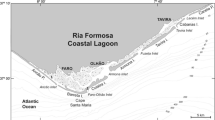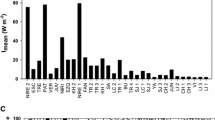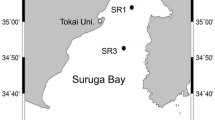Abstract
Tagus estuary is one of the largest estuaries of Western Europe. With the aim of unravelling the drivers of primary production in this shallow and turbid nutrient replete estuary, we tested the hypothesis that light availability is a major factor controlling phytoplankton production. Environmental parameters, phytoplankton biomass, community composition, and photosynthetic parameters were monitored at two sites in the estuary during a complete annual cycle. Despite the fact that nutrient concentrations were always above growth-limiting values, Chl a concentrations were relatively low throughout the study period. High water column turbidity, due to riverine inputs, promoted a rapid attenuation of light and created a compressed profile with optimal photosynthetic conditions. Therefore, the phytoplankton community, dominated by small cells, such as diatoms and cryptophycean flagellates, displayed highly photosynthetic efficiency and low light-saturated photosynthetic rates as a photo-acclimation response to low light conditions year-round. Primary production rate was unimodal, peaking in the summer months. In such estuarine system, gross primary production could thus be predicted by an existing robust empirical model based on pigment standing crop (Chl a), surface irradiance (E 0) and optical depth (Z eup). Compared to other shallow estuaries, the Tagus can be classified as a low- to moderately productive estuary, being the turbidity-induced low light conditions the principal factor limiting phytoplankton growth.









Similar content being viewed by others
Notes
The term “adaptation” is used here on a physiological level, as a phenotypic response of algae to changes in irradiance at the organism level (Falkowski & LaRoche, 1991).
References
Aguirre-Hernández, E., G. Gaxiola-Castro, S. Nájera-Martínez, T. Baumgartner, M. Kahru & B. Mitchell, 2004. Phytoplankton absorption, photosynthetic parameters, and primary production off Baja California: summer and autumn 1998. Deep-Sea Research II 51: 799–816.
Behrenfeld, M. J. & P. Falkowski, 1997. Photosynthetic rates derived from satellite-based chlorophyll concentration. Limnology and Oceanography 42: 1–20.
Behrenfeld, M. J., E. Marañón, D. A. Siegel & S. B. Hooker, 2002. Photoacclimation and nutrient-based model of light-saturated photosynthesis for quantifying oceanic primary production. Marine Ecology Progress Series 228: 103–117.
Bendschneider, K. & N. Robison, 1952. A new spectrophotometric determination of nitrite in seawater. Journal of Marine Research 11: 87–96.
Bouman, H., T. Platt, S. Sathyendranath & V. Stuart, 2005. Dependence of light saturated photosynthesis on temperature and community structure. Deep-Sea Research I 52: 1284–1299.
Boyer, J., R. Christian & D. Stanley, 1993. Patterns of phytoplankton primary productivity in the Neuse River estuary, North Carolina, USA. Marine Ecology Progress Series 97: 287–297.
Bray, J. R. & J. T. Curtis, 1957. An ordination of the upland forest communities of southern Wisconsin. Ecological Monographs 27: 325–349.
Cabeçadas, L., 1999. Phytoplankton production in Tagus estuary (Portugal). Oceanologica Acta 22: 205–213.
Cabrita, M. T., 1997. Inorganic Nitrogen Dynamics in the Tagus Estuary (Portugal)—Spatial and Temporal Variation in Input and Uptake of Nitrate and Ammonium. PhD Dissertation, University of Lisbon, Portugal.
Cabrita, M. T. & M. T. Moita, 1995. Spatial and temporal variation of physicochemical conditions and phytoplankton during a dry year in the Tagus estuary (Portugal). Netherlands Journal of Aquatic Ecology 29: 323–332.
Cadée, G. & J. Hegeman, 1993. Persisting high levels of primary production at declining phosphate concentrations in the Dutch coastal area (Marsdiep). Netherlands Journal of Sea Research 31: 147–152.
Cloern, J. E., 1987. Turbidity as a control on phytoplankton biomass and productivity in estuaries. Continental Shelf Research 7: 1367–1381.
Cole, B. & J. Cloern, 1984. Significance of biomass and light availability to phytoplankton productivity in San Francisco Bay. Marine Ecology Progress Series 17: 15–24.
Cole, B. & J. Cloern, 1987. An empirical model for estimating phytoplankton productivity in estuaries. Marine Ecology Progress Series 36: 299–305.
Cole, J., J. E. Cloern & A. E. Alpine, 1986. Biomass and productivity of three phytoplankton size classes in San Francisco Bay. Estuaries 9: 117–126.
Cole, J., N. Caraco & B. Peierls, 1992. Can phytoplankton maintain a positive carbon balance in a turbid, freshwater, tidal estuary? Limnology and Oceanography 37: 1608–1617.
Côté, B. & T. Platt, 1983. Day-to-day variations in the spring–summer photosynthetic parameters of coastal marine phytoplankton. Limnology and Oceanography 28: 320–344.
Dortch, Q. & T. Whitledge, 1992. Does nitrogen or silicon limit phytoplankton production in the Mississippi River plume and nearby regions? Continental Shelf Research 12: 1293–1309.
Dubinski, Z., 1980. Light utilization efficiency in natural phytoplankton communities. In Falkowski, P. G. (ed.), Primary Productivity in the Sea. Plenum, New York/London: 83–98.
Eppley, R. W., 1972. Temperature and phytoplankton growth in the sea. Fishery Bulletin 70: 1063–1085.
Falkowski, P. G., 1981. Light-shade adaptation and assimilation numbers. Journal of Plankton Research 3: 203–216.
Falkowski, P. G. & J. LaRoche, 1991. Acclimation to spectral irradiance in algae. Journal of Phycology 27: 8–14.
Falkowski, P. G. & J. A. Raven, 1997. Aquatic Photosynthesis. Blackwell Science, Malden, MA.
Fanning, K. & M. Pilson, 1973. On the spectrophotometric determination of dissolved silica in natural waters. Analytical Chemistry 45: 136–141.
Fisher, T., L. Harding Jr., D. Stanley & L. Ward, 1988. Phytoplankton, nutrients, and turbidity in the Chesapeake, Delaware, and Hudson estuaries. Estuarine, Coastal and Shelf Science 27: 61–93.
Gameiro, C. & V. Brotas, 2010. Patterns of phytoplankton variability in the Tagus estuary (Portugal). Estuaries and Coasts 33: 311–323.
Gameiro, C., P. Cartaxana, M. T. Cabrita & V. Brotas, 2004. Variability in chlorophyll and phytoplankton composition in an estuarine system. Hydrobiologia 525: 113–124.
Gameiro, C., P. Cartaxana & V. Brotas, 2007. Environmental drivers of phytoplankton distribution and composition in Tagus Estuary, Portugal. Estuarine, Coastal and Shelf Science 75: 21–34.
Geider, R., T. Platt & J. Raven, 1986. Size dependence of growth and photosynthesis in diatoms: a synthesis. Marine Ecology Progress Series 30: 93–104.
Geider, R., H. MacIntyre & T. Kana, 1998. A dynamic regulatory model of phytoplankton acclimation to light, nutrients and temperature. Limnology and Oceanography 43: 679–694.
Glé, C., Y. Amo, B. Sautour, P. Laborde & P. Chardy, 2008. Variability of nutrients and phytoplankton primary production in a shallow macrotidal coastal ecosystems (Arcachon Bay, France). Estuarine, Coastal and Shelf Science 76: 642–656.
Grasshoff, K., 1976. Methods of Seawater Analysis. Verlag Chimie, New York.
Grobbelaar, J., 1990. Modelling phytoplankton productivity in turbid waters with small euphotic to mixing depth ratios. Journal of Plankton Research 12: 923–931.
Hammer, A., R. Schumann & H. Schubert, 2002. Light and temperature acclimation of Rhodomonas salina (Cryptophyceae): photosynthetic performance. Aquatic Microbial Ecology 29: 287–296.
Harding, L., M. Mallonee & E. Perry, 2002. Toward a predictive understanding of primary productivity in a temperate, partially stratified estuary. Estuarine, Coastal and Shelf Science 55: 437–463.
Harrison, W. G. & T. Platt, 1986. Photosynthesis-irradiance relationships in polar and temperate phytoplankton populations. Polar Biology 5: 153–164.
Hasle, G., 1978. The invert-microscope method. In Sournia, A. (ed.), Phytoplankton Manual. Monographs on Oceanographic Methodology. Unesco Publishers, Paris: 88–96.
Irigoien, X. & J. Castel, 1997. Light limitation and distribution of chlorophyll pigments in a highly turbid estuary: the Gironde (SW France). Estuarine, Coastal and Shelf Science 44: 507–517.
Jassby, A., J. Cloern & B. Cole, 2002. Annual production: patterns and mechanisms of change in a nutrient-rich tidal ecosystem. Limnology and Oceanography 47: 698–712.
Joint, I. & A. Pomroy, 1981. Primary production in a turbid estuary. Estuarine, Coastal and Shelf Science 13: 303–316.
Jumars, P. A., 1993. Concepts in Biological Oceanography: a interdisciplinary primer. Oxford University Press, NY.
Kocum, E., G. Underwood & D. Nedwell, 2002. Simultaneous measurements of phytoplanktonic primary production, nutrient and light availability along a turbid, eutrophic UK east coast estuary (the Colne Estuary). Marine Ecology Progress Series 131: 1–12.
Koroleff, F., 1969/1970. Direct determination of ammonia in natural waters as indophenol blue. ICES Comm. Meet Pap. 1969/C:9, Interlab Report 3.
Kirk, J. T. O., 1994. Light and Photosynthesis in Aquatic Ecosystems, 2nd ed. Cambridge University Press, Cambridge.
Kromkamp, J. & J. Peene, 1995. Possibility of net phytoplankton primary production in the turbid Schelde estuary (SW Netherlands). Marine Ecology Progress Series 121: 249–259.
Kromkamp, J., J. Peene, P. van Rijswijk, A. Sandee & N. Goosen, 1995. Nutrients, light and primary production by phytoplankton and microphytobenthos in the eutrophic, turbid Westerschelde estuary (the Netherlands). Hydrobiologia 311: 9–19.
Lohrenz, S., G. Fahnenstiel & D. Redalje, 1994. Spatial and temporal variations of photosynthetic parameters in relation to environmental conditions in coastal waters of the Northern Gulf of Mexico. Estuaries 17: 779–795.
Lorenzen, C., 1967. Determination of chlorophyll and phaeopigments: spectrophotometric equations. Limnology and Oceanography 12: 343–346.
Martins, M., J. Ferreira, T. Calvão & H. Figueiredo, 1984. Nutrientes no estuário do Tejo: Comparação da situação em caudais médios e em cheia, com destaque para alterações na qualidade da água. I simposio Luso-Brasileiro de Engenharia sanitaria e ambiental.
Monbet, Y., 1992. Control of phytoplankton biomass in estuaries: a comparative analysis of microtidal and macrotidal estuaries. Estuaries 15: 563–571.
Murphy, J. & J. Riley, 1962. A modified single solution method for the determination of phosphate in natural waters. Analytica Chimica Acta 27: 31–36.
Nixon, S. V., 1995. Coastal marine eutrophication: a definition, social causes, and future concerns. Ophelia 41: 199–219.
Nixon, S. W., J. R. Kelly, B. N. Furnas, C. A. Oviatt & S. S. Hale, 1980. Phosphorus regeneration and the metabolism of coastal marine bottom communities. In Tenore, K. R. & B. C. Coull (eds), Marine Benthic Dynamics. University South Carolina Press, Columbia: 219–242.
Oviatt, C., A. Keller & L. Reed, 2002. Annual primary production in Narragansett Bay with no bay-wide winter–spring phytoplankton bloom. Estuarine, Coastal and Shelf Science 54: 1013–1026.
Parsons, T., M. Takahashi & B. Hargrave, 1984. Biological Oeanographic Processes. Pergamon Press, Oxford.
Pennock, J. & J. Sharp, 1986. Phytoplankton production in the Delaware estuary: temporal and spatial variability. Marine Ecology Progress Series 34: 143–155.
Platt, T., C. Gallegos & W. Harrison, 1980. Photoinhibition of photosynthesis in natural assemblages of marine phytoplankton. Journal of Marine Research 38: 687–701.
Platt, T., S. Sathyendranath & P. Ravindran, 1990. Primary production by phytoplankton: analytic solutions for daily rates per unit area of water surface. Proceedings of the Royal Society of London B 241: 101–111.
R Development Core Team, 2005. R: A Language and Environment for Statistical Computing. R Foundation for Statistical Computing, Vienna.
Raven, J., 1998. The twelfth Tansley Lecture. Small is beautiful: the picophytoplankton. Functional Ecology 12: 503–513.
Sakshaug, E., A. Bricaud, Y. Dandonneau, P. Falkowski, D. Kiefer, L. Legendre, A. Morel, J. Parslow & M. Takahashi, 1997. Parameters of photosynthesis: definitions, theory and interpretation of results. Journal of Plankton Research 19: 1637–1670.
Struski, C. & C. Bacher, 2006. Preliminary estimate of primary production by phytoplankton in Marennes-Oléron Bay, France. Estuarine, Coastal and Shelf Science 66: 323–334.
Talling, J. F., 1957. Photosynthetic characteristics of some freshwater diatoms in relation underwater radiation. New Phytologist 56: 29–50.
Tillmann, U., K. Hesse & F. Colijn, 2000. Planktonic primary production in the German Wadden Sea. Journal of Plankton Research 22: 1253–1276.
Underwood, G. J. C. & J. Kromkamp, 1999. Primary production by phytoplankton and microphytobenthos in estuaries. Advances in Ecological Research 29: 93–153.
Vale, C. & B. Sündby, 1987. Suspended sediment fluctuations in the Tagus estuary on semi-diurnal and fortnightly time scales. Estuarine, Coastal and Shelf Science 25: 495–508.
Van Spaedonk, J. C. M., J. Kromkamp & P. R. M. de Visscher, 1993. Primary production of phytoplankton in a turbid coastal plain estuary, the Westerschelde (The Netherlands). Netherlands Journal of Sea Research 31: 267–279.
Verity, P., 1986. Grazing of phototrophic nanoplankton by microzooplankton in the Narragansett Bay. Marine Ecology Progress Series 29: 105–115.
Vollenweider, R. A., F. Giovanardi, G. Montanari & A. Rinaldi, 1998. Characterization of the trophic conditions of marine coastal waters with special reference to the NW Adriatic Sea: proposal for a trophic scale, turbidity and generalized water quality index. Environmetrics 9: 329–357.
Williams, P., 1993. Chemical and tracer methods of measuring plankton production. In Li, W. K. W. & S. Y. Maestrini (eds), Measurement of Primary Production from the Molecular to the Global Scale, Vol. 197. ICES MSS, Copenhagen: 20–36.
Wofsy, S., 1983. A simple model to predict extinction coefficients and phytoplankton biomass in eutrophic waters. Limnology and Oceanography 28: 1144–1155.
Acknowledgments
The authors are grateful to Dr. T. Platt, B. Jesus, P. Cartaxana, M.T. Cabrita and two anonymous reviewers for their valuable ideas and criticisms that greatly improved this paper during analysis of the results and writing of the paper. We also thank R. Mendes for sampling and analytical assistance. This work was funded by Valor Sul SA and FCT by means of project INTAGUS (PDCT/MAR/58022/2004). C. Gameiro was funded by a FCT PhD grant (POCI-2010/BD/13988/2003).
Author information
Authors and Affiliations
Corresponding author
Additional information
Handling editor: Pierluigi Viaroli
Rights and permissions
About this article
Cite this article
Gameiro, C., Zwolinski, J. & Brotas, V. Light control on phytoplankton production in a shallow and turbid estuarine system. Hydrobiologia 669, 249–263 (2011). https://doi.org/10.1007/s10750-011-0695-3
Received:
Revised:
Accepted:
Published:
Issue Date:
DOI: https://doi.org/10.1007/s10750-011-0695-3




